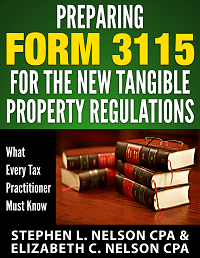 2/17/2015 Update: Information about our TPRs e-book, which has been updated for Revenue Procedure 2015-20, appears at the bottom of page.
2/17/2015 Update: Information about our TPRs e-book, which has been updated for Revenue Procedure 2015-20, appears at the bottom of page.
Mid-year, I blogged about how you need to change the way you’ve been doing your accounting for repairs and maintenance expenses if you run a business or invest in real estate (see here).
As a follow-up to that post, and as the year winds down, I thought it’d make sense to share a couple of additional snidbits.
Implementing Your New Accounting Policy
A first, quick point: in all likelihood, you do want to change the way you’ve done your accounting. In a nutshell, you’ll need to get better about capitalizing some expenditures as improvements. And you’ll need to do a better job at not simply expensing purchases that should be capitalized and then depreciated.
Note, however, that for most small businesses and most small real estate investors this change in accounting method should not be that big a deal. I know, I know. The CPAs are all going nuts about this. But for most small businesses and small real estate investors, the changes in the regulations shouldn’t add that much work. And the changes shouldn’t add noticeably to your tax bill.
As noted earlier, you can read our earlier post (referenced above) for a general overview of the new rules.
Beyond that, what I’d suggest for most small business owners is that, going forward, you formally adopt a written accounting policy that can guide you and/or your bookkeeper in complying with the new regulations. Our firm has created a sample accounting policy for small business owners to reference when doing just that. Basically, what the tax accountants in our office did was distill down the roughly 100 pages of IRS regulations into a six-page, cliffs notes document (provided as a PDF). By adopting this document’s accounting procedures and then trying to follow those procedures, you should end up doing your accounting correctly.
CLICK HERE TO DOWNLOAD ACCOUNTING EXPENSE CAPITALIZATION POLICY DOCUMENT
Note: The links in the PDF point to the Treasury Regulations made available by Cornell University. You can (and should) click those links if you have questions or need further clarification. If what you read doesn’t elucidate, ask your tax adviser.
Obtaining IRS Consent for Your New Accounting Method
While I’m on the subject of these new tangible property regulations and how they force you to tighten up your accounting, one other point should be made. You will likely need to include with your 2014 tax return a Form 3115 that basically alerts the IRS to the fact that you’re making this change to comply with their new rules.
In fact, unless clearly unnecessary, our office will be doing this for almost all of our business tax return and real estate investor return clients.
Final note: Technically, what the Form 3115 does is requests permission to make a change in your accounting methods. This is weird, I grant you that. Why do you have to request permission to make a change in the way you do your accounting when the IRS is the one forcing you to make the change? Yikes!
But it turns out that changing an accounting method can trigger a catch-up adjustment to your taxable income, so that adjustment needs to be figured. Reporting this adjustment is a key part of what the Form 3115 is for.
A Plug for Our e-Book about the New Regulations
With the issuance of Revenue Procedure 2015-20 (which appeared on February 13, 2015) many small businesses may not want to worry about filing 3115s for the TRPs. (See here for our post about the revenue procedure.)
However if you are an accountant with taxpayers that need or want to prepare 3115s for the new TPRs–perhaps to make late partial dispositions elections–you may interested in our ebook on the subject. Note, too, that because nearly every tax accountant will have a few clients who need to make late partial disposition elections, every tax accountant will need to file 3115s for at least a handful of clients.
Accordingly, we’ve prepared a short, slightly-longer-than-60-pages e-book. This downloadable e-book, which a tax practitioner can probably skim through in less than an hour, explains how the new regulations change the way small taxpayers need to do their accounting for tangible property deductions.
The e-book also describes a straight-forward approach to complying with new regulations with a minimum amount of fuss and handwringing, and it includes three sample, completed 3115 forms for the most common (and perhaps only) accounting method change requests small taxpayers will need to make… and also a sample accounting policy which should help a small taxpayer stay in compliance in the future. For $100, you can purchase and immediately download this e-book. Click the button here to make your purchase:
Money Back Guarantee
And an important note: We’re providing a money-back guarantee… if you don’t find our e-book saves you several hours of time and lets you easily prepare 3115s (for which you should be able to charge some multiple of the price you pay for the book) just ask for a refund. (You can email your refund request using the email address we use to send you the download link for the kit.)

In your e-book, you give examples of a Form 3115 for DNC Code 184 and 192 which are very helpful, do you have examples of Form 3115 for DNC Code 187 and 186, especially 187. Thanks
Marion, if you reuse the link you originally used you can get an updated version of the ebook that includes DNC code 186. Sorry, about the omission. A few of the books that we provided the first 24 hours didn’t have code 186… note, too, that we updated the cover image and added a few more links to the primary sources… but it’s the same (slightly better) book.
As far as the code 187, no, sorry, we don’t have that.
I believe there is a significant typo in the Preparing Form 3115 book. It is in the “Note: for Appendix C: Example Form 3115, DCN 186.” You point out that there are two sets of changes to your 186 example to be made in order to request a #187 change. The first change you note is from “non-incidental” to “incidental” and your wording is correct. However, shouldn’t the second change you note read “change the references ‘FROM’ 1.162-3(a)(a) to 1.162-3(a)(2).” You have “change the references ‘TO’ 1.162-3(a)(1) to 1.162-3(a)(2)”
I made a typo at the end of my comment: 1.162-3(a)(a) should be 1.162-3(a)(1)
I believe there is a significant typo in the Preparing Form 3115 book. It is in the “Note: for Appendix C: Example Form 3115, DCN 186.” You point out that there are two sets of changes to your 186 example to be made in order to request a #187 change. The first change you note is from “non-incidental” to “incidental” and your wording is correct. However, shouldn’t the second change you note read “change the references ‘FROM’ 1.162-3(a)(1) to 1.162-3(a)(2).” You have “change the references ‘TO’ 1.162-3(a)(1) to 1.162-3(a)(2)”
In your Form 3115 book, in the “Note: for Appendix C: Example Form 3115, DCN 186,” in order to make the #187 change, in addition to changing “incidental” to “non-incidental” and 1.162-3(a)(1) to 1.162-3(a)(2), I believe there is going to be another change to be made to the #187 wording for the “Proposed Method”. The wording for the 186 change (per 1.162-3(a)(1) states that the materials & supplies will be deducted when first used or consumed. But the Proposed Change” for “incidental” materials & supplies should end with “are deductible in the taxable year in which these amounts are paid, provided taxable income is clearly reflected”.
Thus, in order to use the 186 change as a template for the 187 change, there are three things that must be change:
1. change “non-incidental” to “incidental”
2. change the references to 1.162-3(a)(1) from 1.162-3(a)(1) to 1.162-3)(a)(2)
3. change the wording for the proposed method so that 187 has the proper final clause per 1.162-3(a)(2)
I think those changes sound good, Richard. Thank you for sharing.
Does you book provide guidance on how to calculate the basis of the partially disposed of asset? For example, does it address how to use the producer price index for restorations? Since the consumer price index can no longer be used, does it explain what to do when it comes to betterments and adaptations?
I don’t go into that detail, no. Sorry. BTW I think the treatment in the regs is about three paragraphs. I’ve probably only got a paragraph or so.
You may be wishing for more thorough coverage than is even available at this point–or at least available in sources I know about.